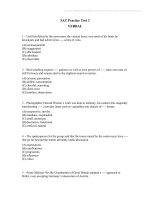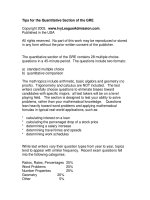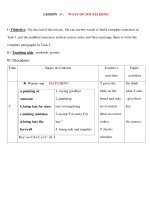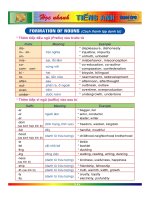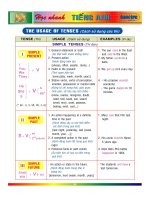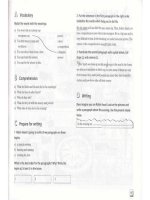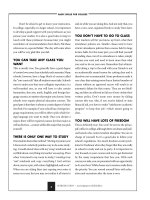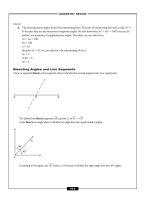Quiz for review 3 issues of economy
Bạn đang xem bản rút gọn của tài liệu. Xem và tải ngay bản đầy đủ của tài liệu tại đây (63.54 KB, 4 trang )
Group 2
Quiz for chapter 2
Three types of economic systems
1.
2.
3.
4.
What question(s) must a society ask to make economic decisions?
A.
What to produce?
B.
How to produce?
C.
For whom to produce?
D.
All of the above
Which type of economy is controlled by the government?
A.
Traditional Economy
B.
Market Economy
C.
Command Economy
D.
Transitional Economy
Which type of economy is shaped largely by custom or religion?
A.
Traditional Economy
B.
Command Economy
C.
Market Economy
D.
Transitional Economy
Which economic system is influenced by Adam Smith's belief of LaissezFaire?
A. Traditional Economy
B.
Command Economy
Market Economy
D.
Transitional Economy
C.
5.
Which group of decision makers is not included in the private sector?
A.
Households
B.
Firms
C.
The Rest of the World
D.
Government
6.
All of the following are examples of a traditional economy except
A. Large scale manufacturing
C. Subsistence agriculture
7.
B. The barter system
D. Hunting and gathering
Which activity would be most characteristic of people in a traditional
society?
A) Having the same occupation as their parents
B) Working in an industrialized cities
8.
C) Serving in government assemblies
D) Establishing a mercantile system of trade
How are major economic decisions made in a command economy?
A) Wholesalers of agricultural goods make most of the decisions
B) Officials of the government control all aspects of economic activity
C) Manufacturers of industrial goods control the resources
D) Supply and demand are determined by consumers of foodstuffs
Which of the following lists the economic systems in the correct order
they would appear on the economic spectrum?
A) Mixed, Command, Free Enterprise
B) Free Enterprise, Command, Mixed
C) Free Enterprise, Mixed, Command
D) Command, Mixed, Free Enterprise
10. The key principle of the economic theory of communism is …
A) The government ownership, control and regulation of property
B) The privatization of business and production of goods and services
C) The restoration of a bartering system in developing countries
D) The organization of workers’ unions in industrialized nations
11. How can one best describe the economy operating under a free
enterprise system?
A) Prices are fixed by agreements among business leaders and labor unions
B) Prices change according to changes in the supply and demand for products
C) All industries except smaller businesses are controlled by the government
D) The government sets the prices of products and the quantity of goods
12. How does a command economy differ from a free market economy?
A) Prices are set by consumers
B) A variety of economic incentives encourage business growth
C) Resources are allocated by government decisions
D) There is a high rate of unemployment
13. What is the function of the government in a command economy?
A) They allow the laws of supply and demand to control the economy
B) They determine the type and quantity of goods to be produced through Five
Year Plans
C) Trade policies mandated that imports exceed exports
D) The success of the agricultural sector controls the manufacturer's goods
14. In which economic system would a person expect the widest selection
of consumer goods?
9.
A) Socialist
B) Communist
15.
Which group has the greatest influence in determining what goods and
services will be produced in a communist economic system?
A) Consumers
B) Farmers
16.
C) Traditional
D) Free Enterprise
C) Government officials
D) Bankers
True or False:
a.
b.
The main goal of Mixed economy is to gain private property.
An economic system in which business are allowed to produce any goods
c.
and services they wish to is referred to as a centrally planned economy.
A situation that occurs when two or more businesses try to sell the same
d.
type of product to the same customers is referred to as competition.
When deciding "what to produce", population and resources are said to
e.
f.
be limited.
The items that consumers buy are called producer goods.
A centrally planned economy promotes government ownership, profit
g.
and no competition.
An economic system that has Government restrictions on the actions of
h.
i.
individuals and businesses is called a centrally planned economy.
In a free enterprise, private property is discouraged.
The term that indicates ownership, either by individuals or by a business,
j.
is private property.
Uneven distribution of resources, consumer difficulty in obtaining
information, and health-risk products are limitations of Free Enterprise
Systems.
Answer Key
1. D 2. C 3.C
4.C
13.B 14.D 15.C
5.D
6.A
7.A
8.B
9.C
10.A 11.B
16. True / false
a. T
b. F (Free Enterprise)
c. T
d. F (Resources is limited)
e. F (consumer goods)
f. T
g. F (a mixed economy)
h. F (encouraged)
i. T
J. T
12.C
